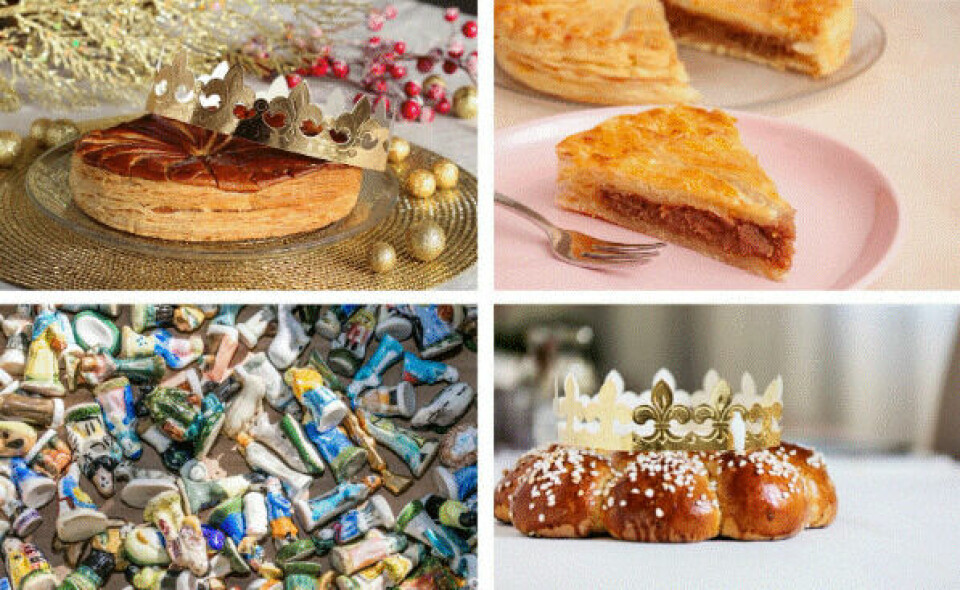France’s galette des rois: Six facts about this January 6 cake
Epiphany marks the Three Wise Men bringing gifts to the baby Jesus. We look at how France celebrates with a special sweet treat
Can you spot the ‘galette’ from the ‘pithiviers’ and the ‘nourolle’?
Shutterstock / Nicolae Cirmu / Aygul Bulte / STUDIO GRAND WEB / Natalia Ruedisueli
January 6 marks Epiphany, a feast day that celebrating the coming of the Three Wise Men (or Three Kings) to give their gifts to the baby Jesus.
In France, the occasion is celebrated with a galette des rois (cake of kings), which is normally made up of frangipane-filled puff pastry or is a brioche ring decorated with candied fruit.
It contains a little figurine (the fève) which is often said to represent the Christ Child but can now include a number of themes including Disney characters.
Tradition has it that the youngest person present sits under the table and shouts out the names of people to get certain slices as the cake is cut.
Whoever finds the fève in their slice gets to wear a crown supplied with the cake from the bakers or supermarket from where it was bought, and in some families, gets to make up rules everyone must follow for the remainder of the day.
We look at the origins of the galette des rois and how the tradition has evolved over the years.
Origins
The galette is thought to date back to the Saturnalia, the Roman celebration of the winter solstice and celebrated prior to the birth of Jesus Christ, Nadine Cretin, a historian who specialises in Western traditions and celebrations, told L’Express.
During the Saturnalia traditional societal roles were overturned and slaves and slaveowners met together to eat at one table.
On this occasion, a fève would also be used to pick out a ‘king for the day’ from the slaves.
In the Catholic tradition, the galette forms part of the celebrations commemorating the revelation of God incarnate as Jesus Christ.
Eastern churches use January 6 to celebrate the baptism of Christ in the Jordan river.
Recipe variations
Its recipe - and name - varies across France and include:
‘Galette des rois’
This is the most commonly-used name for the cake in France, which is known as such even in areas where the cake is not available in this form.
The galette is generally made from puff pastry and frangipane, although the recipe differs slightly from one region to another.
For example, bakers in Dunkirk stuff brioche with buttery cream and rum, while in Franche-Comté the galette is choux pastry flavoured with orange blossom water or rum.
‘Nourolle’
‘Nourolle’ is the name used in Normandy, where the 12 apostles are celebrated with 12 brioche-pastry balls made into one pie. ‘Nourolle’ is meant to be broken by hand, each guest getting their own ball.
‘Gâteau des rois’
Parts of southern France use this name for the cake. In these regions, it is often a cake or brioche decorated with candied fruit or sugar crystals.
This variation on the galette is named differently in some southern cities: for example, Montpellier has a ‘royaume’, Bordeaux a ‘couronne’ and Moissac a ‘coque des rois’.
People in Gascogne and Béarn often call it ‘garfou’ or ‘galfou.’
‘Pithiviers’
This is the name for the pastry in Loiret. Pithiviers can either be savoury or sweet. The sweet version is stuffed with almond cream.
If you want to try your hand at making a classic galette des rois, see our recipe below.
Read more: RECIPE: How to make a ‘perfect’ French galette des rois
The president’s galette has neither fève nor crown
“There is no fève in the galette [eaten at the Elysée Palace] because there is no king at the Elysée,” President Macron told journalists as part of a traditional annual speech begun in 1975 by former president Valéry Giscard d’Estaing.
This is, of course, because France is a Republic and the crown is attached to the idea of monarchy, a regime which France ended during the French revolution in 1789.
Forgotten and current traditions
A medieval tradition once dictated that the winner of the fève would buy drinks for all of the guests at the table which often led to fights or tactics to avoid winning.
This custom dates back to the 14th Century, when the winner would stand up and the people sitting at the table would shout ‘Le roy boit!’ (The king drinks).
This would be repeated whenever a guest raised his or her arm to honour the ‘king’ and shout the order again.
Sometimes people would deliberately swallow the fève or hide it in the slice of the galette that was kept to be given to the poor, for fear of having to pay for everyone’s drinks.
Some still offer drinks to everyone at the table if they win the figurine or offer to host the next galette des rois at their home.
Fève and crown collectors have their own official names
Some people collect fèves and are called fabophiles. France’s most successful fabophile is 83-year-old Jacqueline Goepfert, who has 167,000 fèves.
Read more: Learn about France's fabophiles
People who collect galette crowns are called stephanophiles.
A 2014 survey found that 85% of people in France celebrated Epiphany, despite it being a religious holiday and one that does not coincide with a day off from work (unlike Easter or Assumption).

























